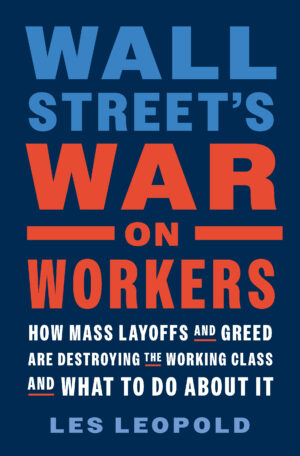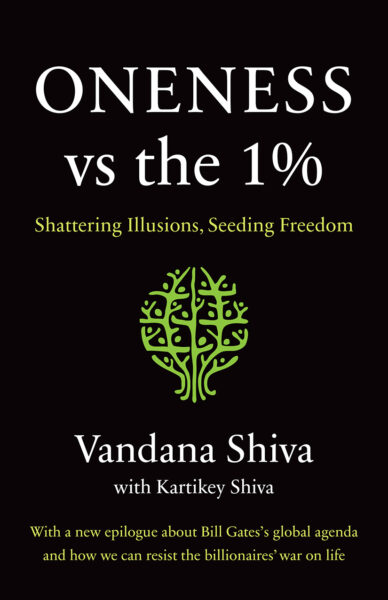Mass Layoffs: Destructiveness and Doubt

Addressing the pressing issues affecting everyday Americans is essential—and one of our nation’s most profound challenges is the devastating impact of mass layoffs. Layoffs upend people’s lives, cause enormous stress, and lead to debilitating personal debt. The societal harm caused by mass layoffs has been known for decades. Yet, we do little to stop them. Why? Keep reading to learn more about the cause and effect of mass layoffs.
The following is an excerpt from Wall Street’s War on Workers by Les Leopold. It has been adapted for the web.
The Effects of Mass Layoffs
“How do you keep going, feeling this depressed or this sad? That’s what it was like. When you knew that this was definitely going to happen, it was like grieving.” —Mary, age 60, laid off after 18 years of service
“It was like suffering through a death, and I went through a deep depres sion. I think that’s another reason why I didn’t want to go searching for a job. I felt, I don’t know, [it] just made me feel unappreciated and worthless. I had no confidence in myself after that.” —Lori, age 57, laid off after 26 years of service
These gutwrenching accounts from the victims of mass layoffs in 2020 echo the pain and suffering of America’s laidoff workers over the last four decades.1
The Mass Layoff Wave
The first mass layoff wave in the post–World War II era focused on manu facturing workers as the Rust Belt formed and corroded during the 1970s and 1980s. Then, in the 1990s, whitecollar professionals found that their shiny offices were not immune.
Now, workers in the tech industry are under assault: 1,060 companies dumped 164,744 workers in 2022, and another 213,298 in the first half of 2023.2
The disturbing statements above, however, do not come from the business sector.
Rather, these are voices from among the 113 unionized food service and cleaning workers terminated by Oberlin College, my alma mater, six months into the pandemic. (Around 50 of these workers managed to find employment with one of the subcontractors.)*
Using Layoffs to Cut Costs
 This nonprofit progressive college—“the first college in America to adopt a policy to admit Black students (1835) and the first to grant bachelor’s degrees to women (1841) in a coeducational program,” according to the college’s website3 chose to cut costs by terminating these workers, many with decades of service, and replacing them with lowerwage subcontractors.
This nonprofit progressive college—“the first college in America to adopt a policy to admit Black students (1835) and the first to grant bachelor’s degrees to women (1841) in a coeducational program,” according to the college’s website3 chose to cut costs by terminating these workers, many with decades of service, and replacing them with lowerwage subcontractors.
In doing so, Oberlin adhered to the Wall Street employee handbook.
Rule #1: Workers must be reduced to mere numbers. Rule #2: Workers are expend able. Rule #3: Loyalty is irrelevant.
Finally, the most sacred rule of all, Rule #4: Bottomline financial calculations trump all other considerations.
And so, Oberlin saw absolutely no reason to factor into their decision making calculus the harm done to these workers, nor the consequences to the surrounding town, which was already saddled with a 24.9 percent poverty rate.4
The harm so studiously ignored is considerable.
Living With Layoffs
Layoffs upend people’s lives. They cause extraordinary levels of stress, loss of confidence, and financial insecurity, including depleted savings and, often, increased debt.
Medical studies have shown that the trauma of unemployment causes disease.5
The Trauma of Unemployment
Sandra Sucher and Marilyn Morgan Westner, writing in the Harvard Business Review, reported on additional research that reveals the vast extent of the personal suffering caused by unemployment:6
- Losing your job is the seventh most stressful life event, ranked more stressful than “divorce, a sudden and serious impairment of hearing or vision, or the death of a close friend.”
- Recovery from the psychological trauma of job loss takes two years on average.
- Even for those without preexisting health conditions, “the odds of developing a new health condition rise by 83 percent in the first 15 to 18 months after a layoff, with the most common conditions being stress related illnesses, including hypertension, heart disease, and arthritis.”
- The stress of a layoff “can increase the risk of suicide by 1.3 to 3 times. Displaced workers have twice the risk of developing depression, 4 times the risk of substance abuse, and 6 times the risk of committing violent acts including partner and child abuse.”
- Stress from layoffs can “impair fetal development.”
- For many layoff victims the loss of income “can last for the remainder
- of their careers: Workers who lost their jobs during the 1981 recession saw a 30 percent decline in earnings at the time of their layoff. Twenty years later, most still earned 20 percent less than workers who retained their jobs—the cumulative effect of unemployment, underemployment, and an inability to find work commensurate with their skills.
As mass layoffs devastate rural areas, they become opioid death zones, supplying a disproportionate number of the nation’s overdose victims, now totaling more than 100,000 deaths per year.7
Little wonder that even the US Department of Labor recognizes that “being laid off from your job is one of the most traumatic events you can experience in life.”8
The enormous harm caused by mass layoffs has been known for decades. Yet, we do little to stop them.
How Do We Stop Mass Layoffs?
There are no laws in the United States to protect working people from “mass layoffs” (defined by the Bureau of Labor Statistics as 50 or more workers losing their jobs at a single company during a fiveweek period).
Public outrage about layoffs is, at best, localized, while new mass layoffs are announced without much fanfare each day across the country.
Layoffs have become so commonplace, so normalized, so routinized, that forprofit and nonprofit executives alike do not hesitate to slash jobs whenever they feel it necessary—and they alone have the authority to define “necessary.”
The “Justification” of Layoffs
There’s always a justification. Costs need to be cut because competition demands it. Nonprofit colleges lay off workers to keep tuition increases down as they compete for students. Budgets must be balanced, “structural deficits” addressed, and endowments protected.
A halfcentury earlier, it would have been difficult for Oberlin to find less expensive workers to replace those they had laid off. At that time, a booming industrial economy surrounding the college in northeast Ohio depended on wellcompensated labor.
History of Mass Layoffs
Steel mills and auto factories, refineries, and chemical plants were working three shifts to meet demand spurred by the war in Vietnam and the War on Poverty.
And trade unions, about four times the size of today’s labor organizations, were powerful enough to cripple companies—or colleges—that dared to engage in unionbusting activities.*
But the Reagan revolution, which attacked unions and deregulated Wall Street, led to a dramatic shift in how corporate capitalism functioned, and eventually how nonprofits would as well.
In short order, hostile corporate takeovers became routine, massive debt was piled onto corporate balance sheets, and stock buybacks—using corpo rate money to repurchase the company’s shares to raise their price—became legalized.
(In times past, stock buybacks were considered stock manipula tion, and stock manipulation was considered a contributing cause of the 1929 stock market crash.)
De-Regulating Wall Street
 The deregulation of Wall Street in the name of freemarket ideology made it possible for investment bankers and corporate raiders (that we now politely call private equity companies and hedge funds) to strip wealth away from corporations and their employees.
The deregulation of Wall Street in the name of freemarket ideology made it possible for investment bankers and corporate raiders (that we now politely call private equity companies and hedge funds) to strip wealth away from corporations and their employees.
This slashandburn mentality increasingly moved wealth into the hands of the few while leading to devastating job losses again and again, especially in manufacturing areas like northeast Ohio.
The Democratic Party, pressed by labor unions, considered legislation to inhibit corporate shutdowns and mass layoffs.
Its 1984 presidential platform urged that workers should have “actual ownership of the company, employee representation on corporate boards, quality work circles, and greater worker participation in management decisions.”
In addition, the platform called for the government to “encourage employee participation and ownership, particularly as an alternative to plant shutdowns.”
“It is destructive of labormanagement relations when concessions extracted from labor to preserve jobs are converted after the restoration of profitability into management bonuses, rather than restoring the concessions that the workers made,” said the Democratic Party presidential platform statement of 1984. “Such practices offend our sense of fairness, as does the Reagan Administration–inspired unionbusting.”9
Financial Deregulation
Rather than fulfill these pledges, the next Democratic administration, under Bill Clinton, doubled down on financial deregulation—from deregulating derivatives to allowing risky investment banks to merge with commercial banks, leading to more mass layoffs.
In effect, both parties were competing for Wall Street’s favor. The victims of mass layoffs were political orphans.
Of course, there was always a lofty excuse, packaged as a bold new vision that claimed the job carnage was necessary to modernize our economy, meet the foreign competition, and create a better future for us all.
The unleashing of Wall Street, and the reasoning to justify it, became so prevalent for so long that few can remember a time when job destruction was not routine.
What Do Mass Layoffs Mean for Companies?
 But before financial deregulation, corporate leaders considered mass layoffs a sign of their own failure—an indication that they had misread markets, failed to anticipate competitive needs, and didn’t invest enough in research, development, and worker training to build thriving, longlasting enterprises.
But before financial deregulation, corporate leaders considered mass layoffs a sign of their own failure—an indication that they had misread markets, failed to anticipate competitive needs, and didn’t invest enough in research, development, and worker training to build thriving, longlasting enterprises.
To be sure, during recessions they might be forced to cut jobs, but not during periods of general economic expansion.
Today, in good times and bad, jobs are cut. What formerly was considered failure is now considered smart management, the coin of the realm in every MBA program. It has become axiomatic that cutting jobs is what smart managers must have the guts to do.
Why Don’t We Question Layoffs More?
As Wall Street has routinized the financial stripmining of productive enterprises, more than 30 million of us have experienced mass layoffs.* And even more have felt the pain and suffering as our family members lost jobs.
Most mass layoff victims experience it as one of the most traumatic events of their lives. For people in rural areas, where many layoffs have occurred, the trauma is even more extreme, since decent jobs there are scarce.
When jobs do open up, scores of colleagues, friends, and neighbors line up and compete for them. This cruelty—this mass destruction—is baked into mod ern financialized capitalism, including at nonprofit colleges like Oberlin.
And it is rarely questioned, now that financialized management has oozed into college administrations, boards of trustees, and their endowments.
Recommended Reads
Recent Articles
Addressing the pressing issues affecting everyday Americans is essential—and one of our nation’s most profound challenges is the devastating impact of mass layoffs. Layoffs upend people’s lives, cause enormous stress, and lead to debilitating personal debt. The societal harm caused by mass layoffs has been known for decades. Yet, we do little to stop them.…
Read MoreWhat does facing the beast mean? In this time of uncertainty, we must practice regular reflection to achieve optimal happiness and health. The metaphor below gives insight into confronting and facing it, regardless of what “the beast” is to you. The following is. an excerpt from Facing the Beast by Naomi Wolf. It has been adapted for the…
Read MoreIn a personal investigation into ethical and traceable leather, fashion designer Alice Robinson begins a ground-breaking journey into the origin story of leather and its connection to food and farming. Keep reading to learn more about her process of cutting & shaping leather to create handbags, shoes, clothing, and more! The following is an excerpt from…
Read MoreWe’ve all heard of the phrases “time flies” and “time heals all wounds,” but what really is time, and how does it impact our lives? The concept of time may be even more powerful than we think, especially when it comes to the money we save and spend. The following is an excerpt from The…
Read More“Climate change asks us questions that climate science cannot answer,” — Dougald Hine When it comes to climate change, it seems as if there are always new questions arising: How did we get to this point? How can we stop it? What’s next? Unfortunately, there is no black-and-white, straightforward answer to any of them —…
Read More









